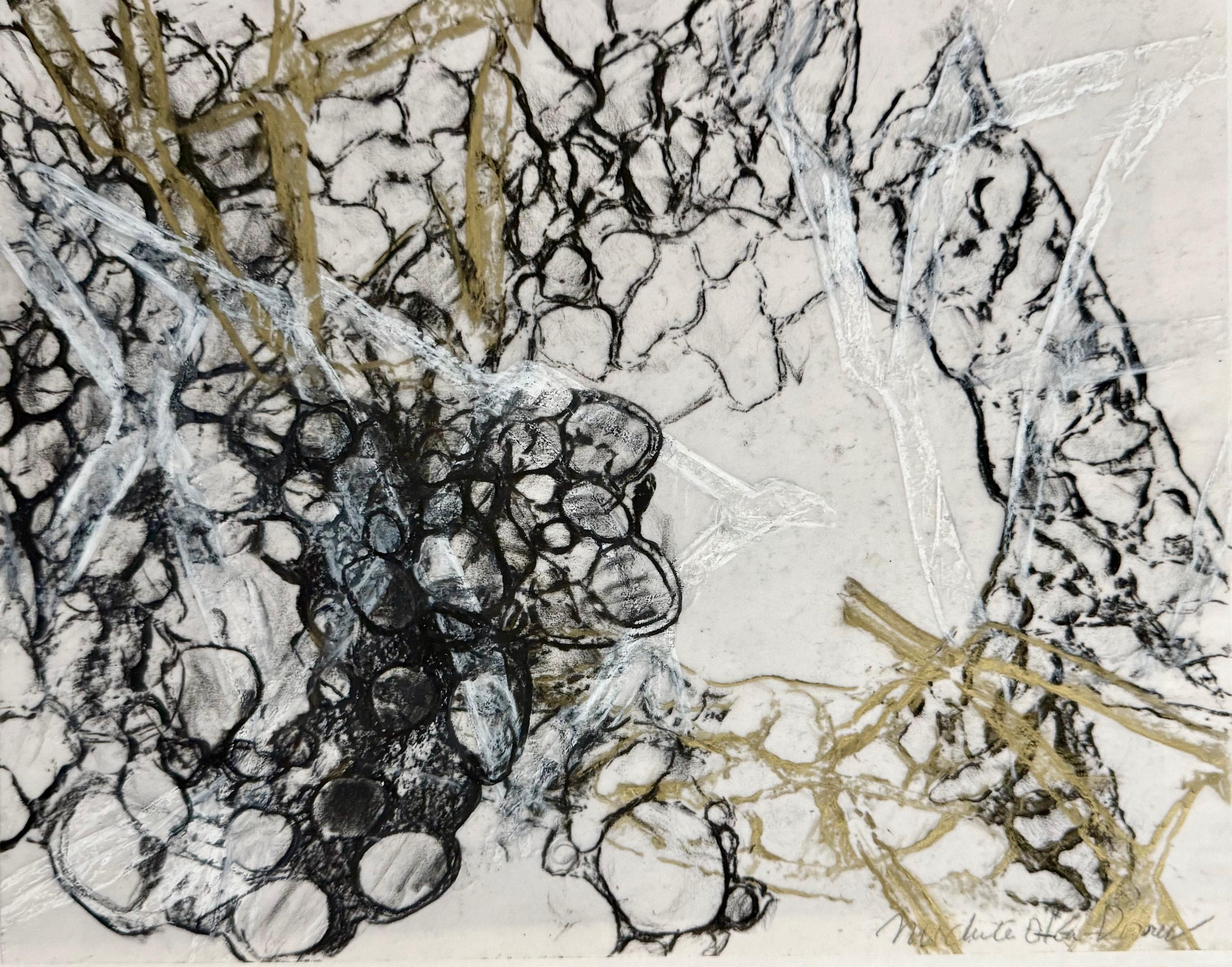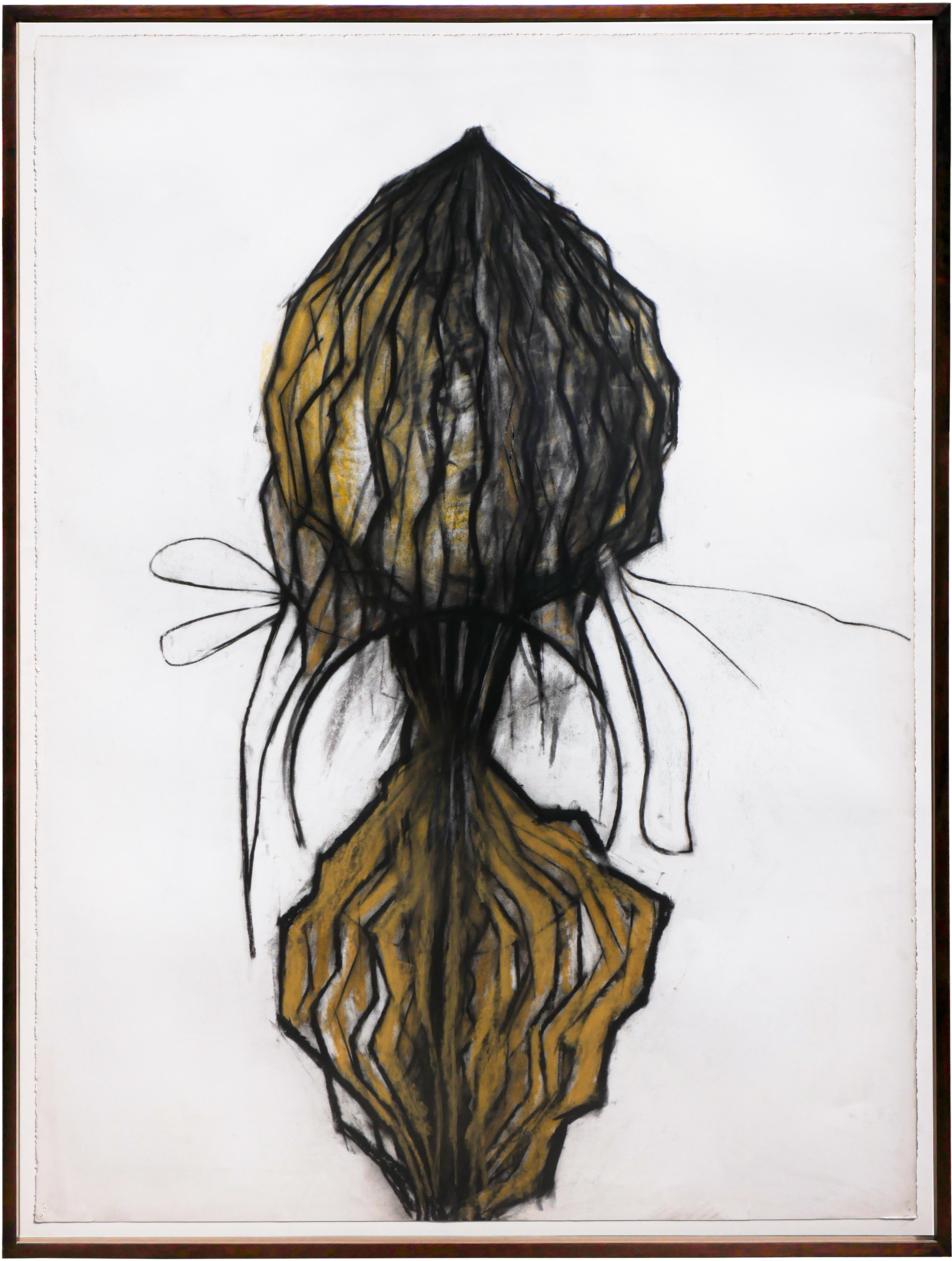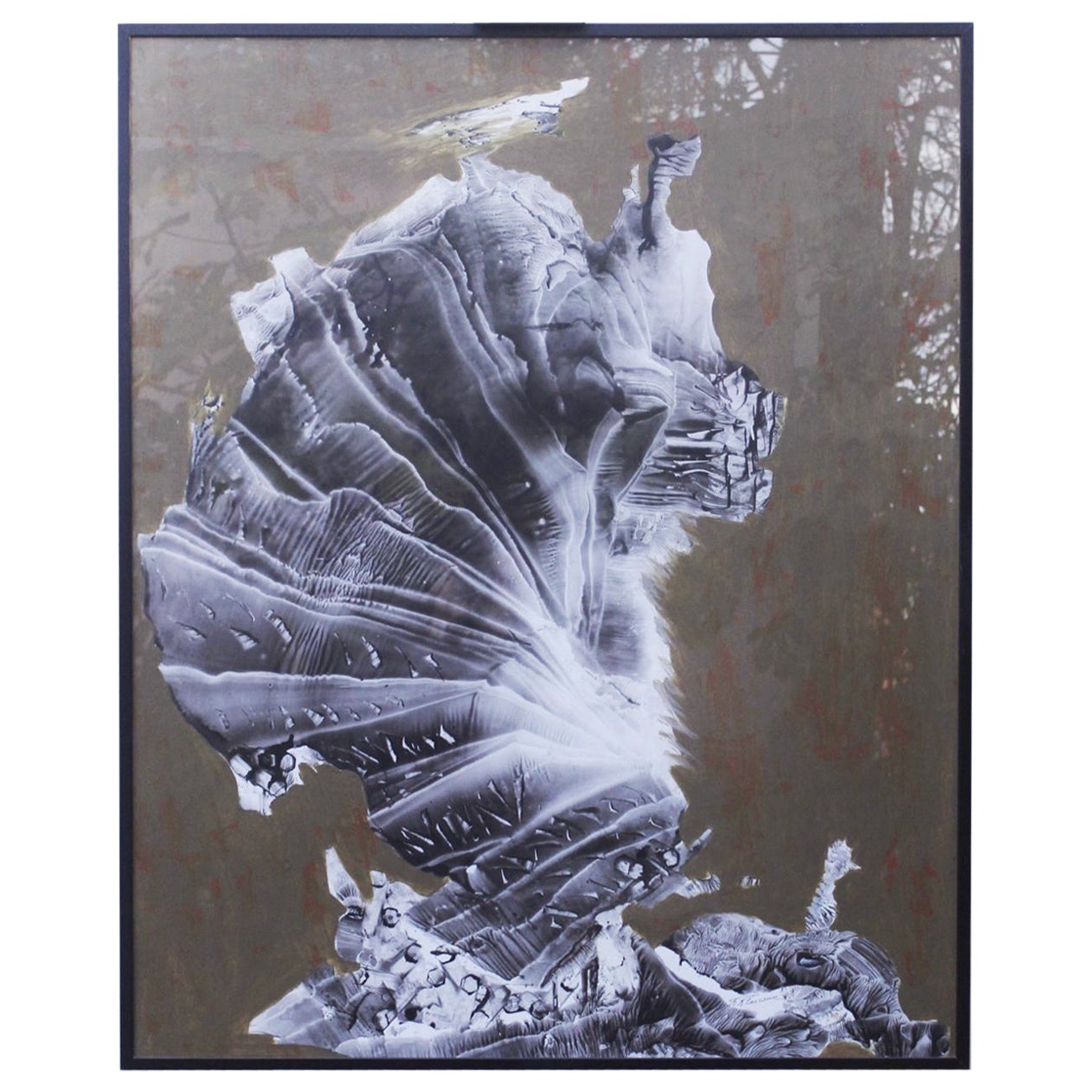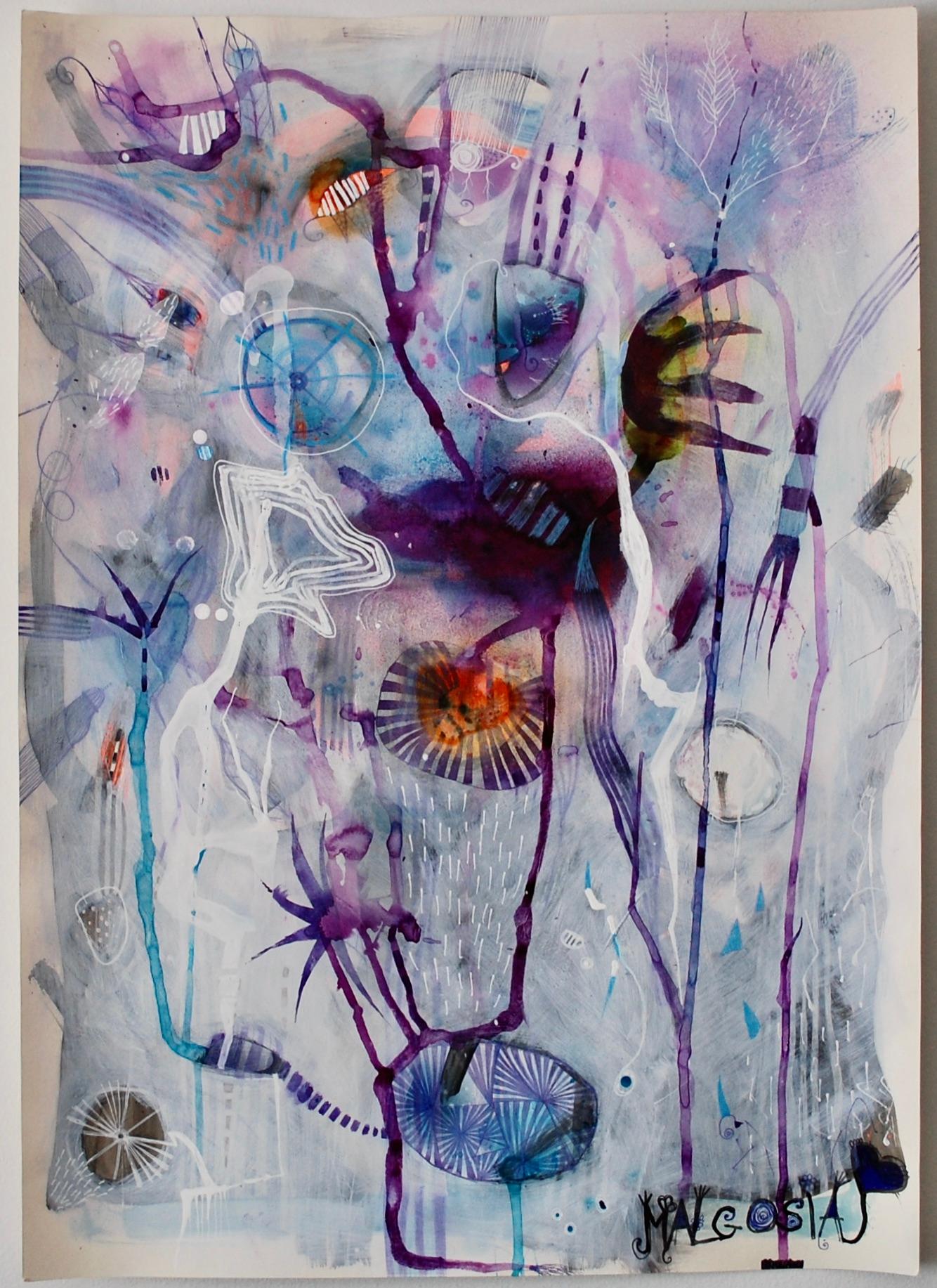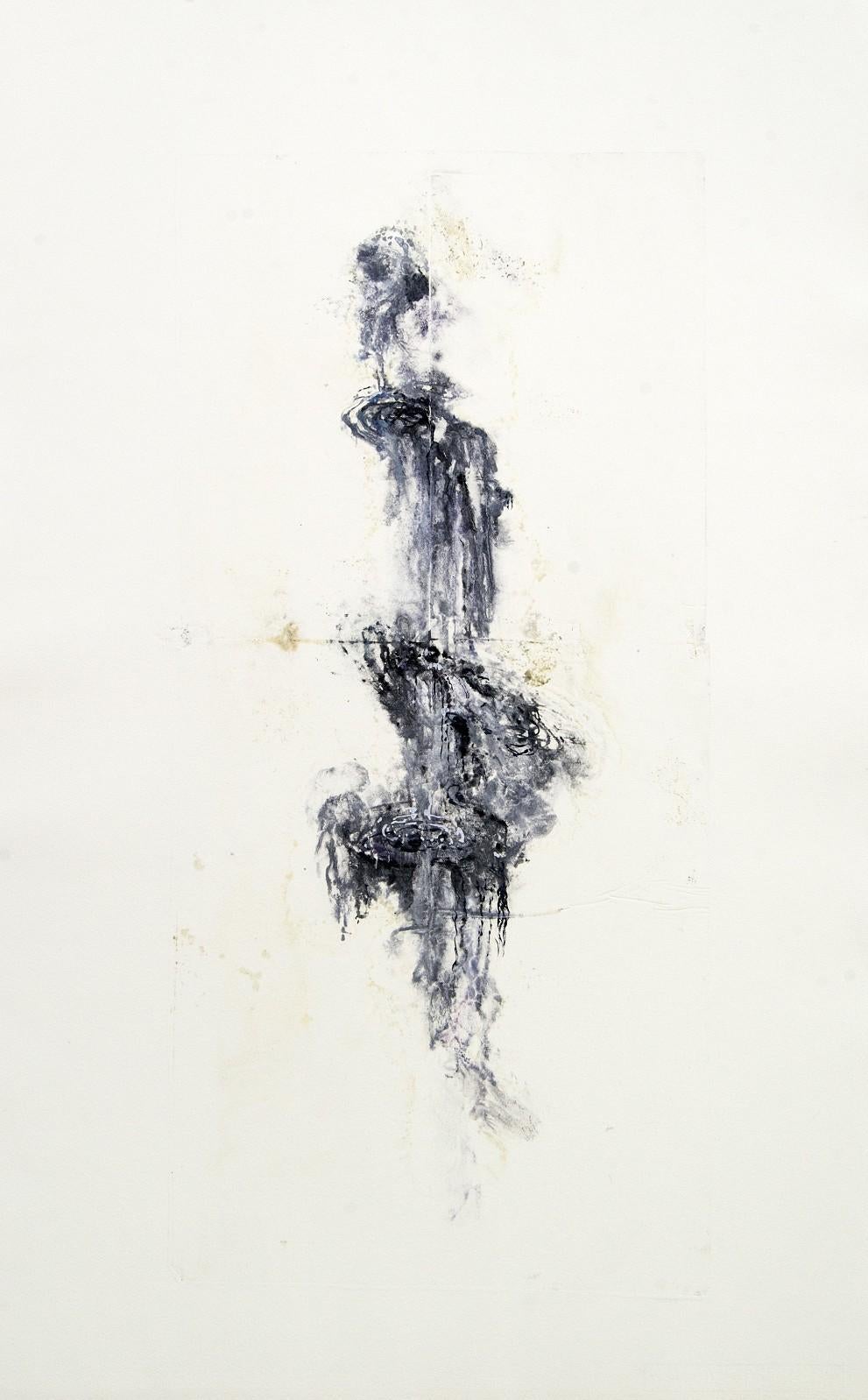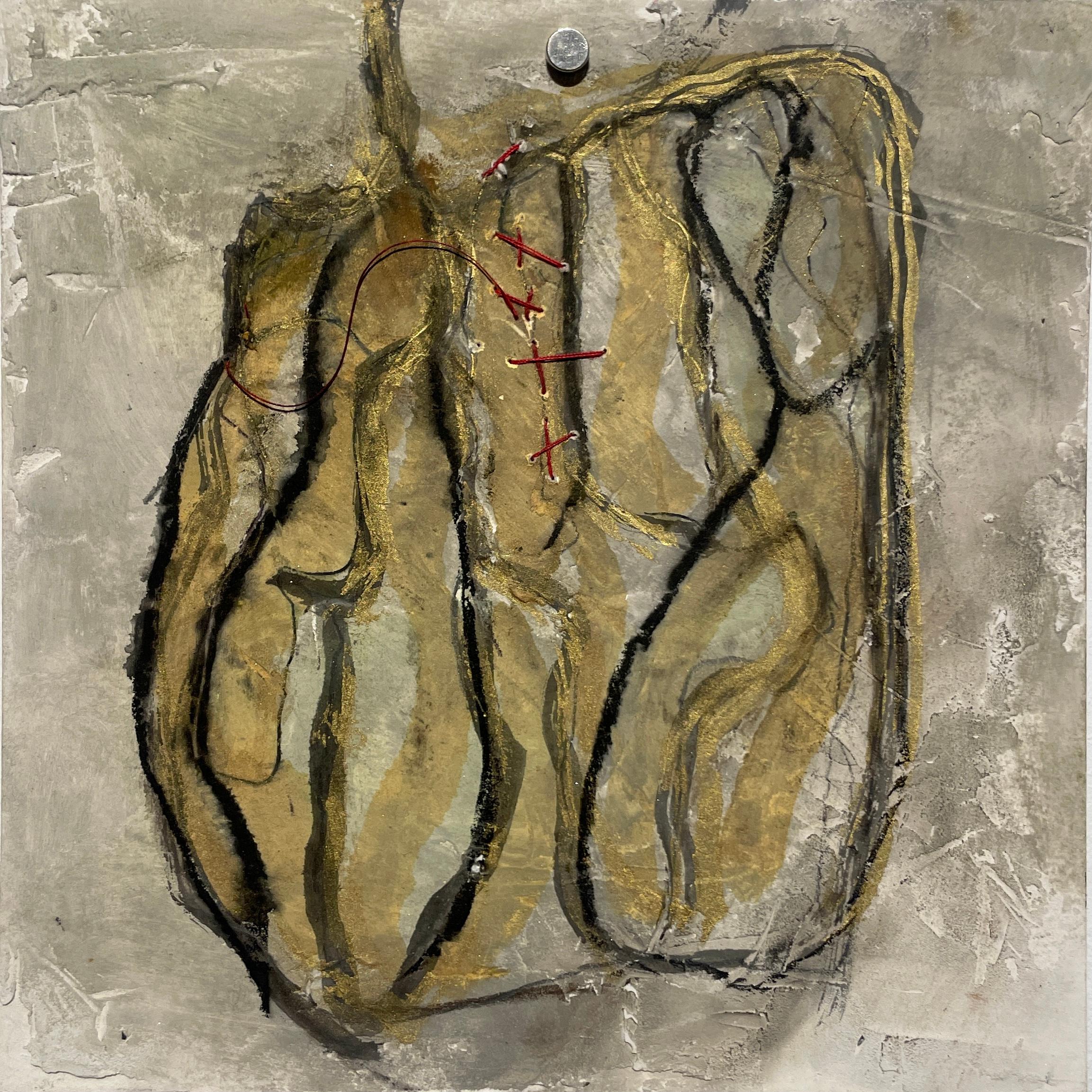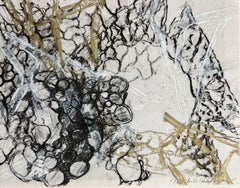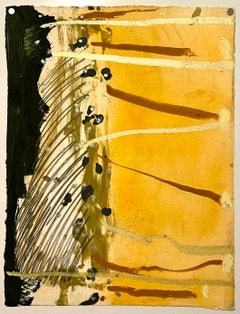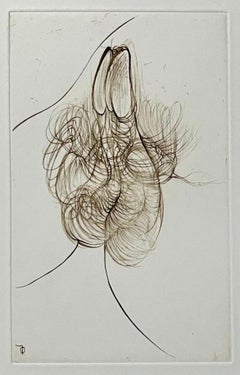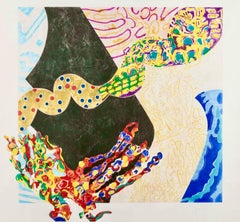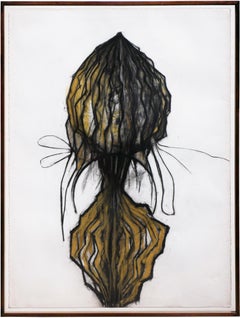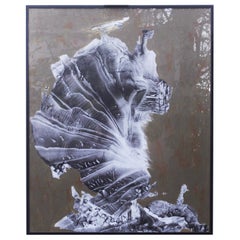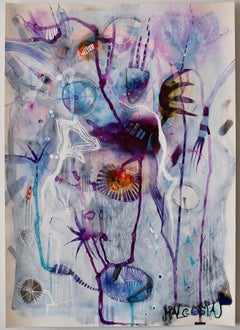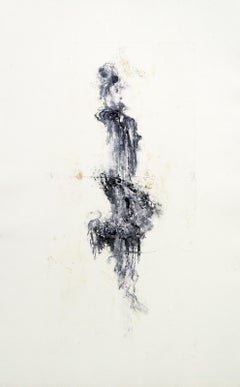Items Similar to Original Drawing Painting Abstract Biomorphic Art Gold Leaf Michele Oka Doner
Want more images or videos?
Request additional images or videos from the seller
1 of 15
Michele Oka DonerOriginal Drawing Painting Abstract Biomorphic Art Gold Leaf Michele Oka Doner2004
2004
$2,500
£1,885.65
€2,177.94
CA$3,502.67
A$3,894.77
CHF 2,038.98
MX$47,575.35
NOK 25,621.83
SEK 24,102.46
DKK 16,258.17
About the Item
This is mixed media. I am not positive of the materials. it is a translucent, vellum, parchment type of paper. with either charcoal or ink and gold leaf (or gold paint) hand signed in pencil lower right.
It is not titled on it.
Michele Oka Doner (born 1945, Miami Beach, Florida, United States) is an American artist and author who works in a variety of media including sculpture, lithograph and woodcut prints, drawing, watercolor painting, functional objects and video. Her workes is based on flora, fauna, DNA and all sorts of exotica. She has also worked in costume and set design and has created over 40 public and private permanent art installations, including her best known artwork is "A Walk on the Beach" (1995, 1999), and its extension, "A Walk on the Beach: Tropical Gardens" (1996–2010) at the Miami International Airport. It is composed of over 9000 bronzes embedded in terrazzo with mother-of-pearl. At one and quarter linear miles, it is one of the largest artworks in the world.
Born and raised in Miami Beach, Oka Doner is the granddaughter of painter Samuel Heller. Oka Doner's father, Kenneth Oka, was elected judge and mayor of Miami Beach during her youth (1945–1964). The family lived a public and politically active life. In later years, Oka Doner co-authored, with Mitchell Wolfson Jr. Miami Beach: Blueprint of an Eden, an intimate portrayal of Miami Beach from the 1920s to the 1960s using their families as prisms to reflect the times. Reviewed as classic of social history, with material that was part of the public record of its time, it was used as a textbook in Human Geography at George Washington University in 2008.
In 1957, age 12, Oka Doner began a year-long independent project studying the International Geophysical Year (IGY). She assembled a book of drawings, writings and collages that became a template for projects realized in later years. In 1963, Oka Doner left Florida for the University of Michigan, Ann Arbor. Her art instructor Milton Cohen was experimenting with The Space Theater and George Manupelli began the Ann Arbor Film Festival. Their students were engaged in poetry, dance, light, music, all combined into a unitary vision, a motif that shaped Oka Doner's student years and is characteristic of her work today. Oka Doner participated in a Manupelli experimental film, a "Map Read" performance with art drawing instructor Al Loving and Judsonite dancer Steve Paxton as well as several "Happenings." Another influence was art historian and Islamic scholar, Oleg Grabar, who illustrated how patterns in architecture are able to dissolve space. A Death Mask, one of her first works, was selected as the cover of Generation, the University's avant garde journal, as campus unrest over the Vietnam war escalated. Her Tattooed Porcelain Dolls were adopted by students protesting the U.S.'s use of napalm... their heads (when they have them) with eyes closed, moth half-open and brain visible, fall into the category of surrealistic objects, but with a surrealism filled with a sap which is naive, barbaric and young."
Oka Doner received a Bachelor of Science and Design from the University of Michigan (1966), a M.F.A. (1968), was Alumna-in-Residence (1990), received the Distinguished Alumna Award from the School of Art (1994) and was a Penny Stamps Distinguished Speaker (2008). She was awarded the honorary degree, Doctor of Arts (2016).
Upon graduation in 1968, Oka Doner established a studio in downtown Ann Arbor behind the art gallery "Editions, Inc.," where physicist Lloyd Cross and sculptor Jerry Pethick were experimenting with holography. Using a krypton laser, they created the first art holograms. One of Oka Doner's sculptures was appropriated for this experiment. The "Ceramic Doll" opened in the world's first exhibition of holograms at the Cranbrook Academy Art in 1970. Oka Doner moved to Detroit and exhibited at the Gertrude Kasle Gallery in 1971. In 1975, a new body of work, Burial Pieces was laid out on the floor of Gallery 7, then a Cooperative Gallery of black artists, led by Charles McGee. It was the first of many installations that shed pedestals and traditional ways of displaying sculpture. A one-person show at the Detroit Institute of Arts followed in 1977. Works in Progress, also forsook conventional props. Oka Doner installed on the floor of the North Court thousands of pieces of clay depicting images of writing and seeds in the process of germinating. In 1979, the DIA initiated a small group exhibition, "Image and Object in Contemporary Sculpture," including Michele Oka Doner, Scott Burton, Dennis Oppenheim, and Terry Allen, which traveled to P.S. 1, New York.
In 1981, Oka Doner moved to New York City and embarked on a series of public art installations. In 1987, she won a national competition sponsored by the MTA's Arts For Transit Program with Radiant Site a 165 ft. long wall for the Herald Square subway station in New York City. The late architect Morris Lapidus said of "Celestial Plaza," "By laying these forms at our feet, she encourages us to stop and search the sparkling expanse for landmarks just as we would search the night sky."
In 2009–2010, Oka Doner installed SoulCatchers, approximately 400 shamanistic sculptures in the kiln room at the Nymphenburg Porcelain Manufactury, Munich, Germany.).
Solo exhibitions of her work have been held at the Detroit Institute of Arts, Michigan; Germans Van Eck, Diane Brown, Art & Industrie, Willoughby Sharp and Marlborough Gallery in New York, Studio Stefania Miscetti in Rome; and Gloria Luria Gallery in Miami, Florida.
Recent solo exhibitions include, "Close Your Physical Eye," Manitoga Arts Center, Garrison, New York (2019); "New Works on Paper," Marlborough Gallery, New York (2019), " "How I Caught A Swallow in Mid-Air," at the Perez Art Museum Miami PAAM (2016), "Mysterium" at David Gill Gallery, London (2016), "Feasting on Bark," Marlborough Gallery, New York (2015), "The Shaman's Hut," Christie's gallery, New York (2014), "Neuration of the Genus," Dieu Donne Gallery, New York, NY, where she was interviewed by the artist Adam Fuss, and "Exhaling Gnosis" at Miami Biennale (2011). Her first video, A Walk on the Beach premiered at Art Basel Miami Beach (2011) in the public screenings "Art Video" program in SoundScape Park on the 7,000 square foot outdoor projection wall of the New World Center. Oka Doner designed her first sets and costumes for Miami City Ballet's production of George Balanchine's "A Midsummer Nights Dream" (Spring, 2016 and Spring, 2019) Sets and costumes were inspired by images of undersea creatures photographed at the Marine Invertebrate Museum collection at the Rosenstiel School of Marine & Atmospheric Science at the University of Miami, Prof. Nancy Voss, Director Additionally, Michele Oka Doner created a large-scale art installation, “Mangrove Retreat,” in 2015 for Art Basel Miami Beach using Sunbrella fabric. She did a commission for the Jewish Museum in New York. In the 1980s Jewish feminists introduced a new component to the passover seder, honoring the prophet Miriam, sister of Moses, who led women in song and dance after the escape of the Jews from Egypt. A cup named for her is placed on the table beside the traditional cup of wine reserved for the prophet Elijah. The (judaica) Miriam Cup holds water, symbolic of the well of fresh water that accompanied Miriam as the Jews wandered the desert after their flight. Hers was made of Silver, cast and hand-worked.
She was included in the book "50 Contemporary Women Artists" along with notables
Judy Chicago, Kara Walker, Zoe Buckman, Maya Lin, Mickalene Thomas, Shirin Neshat & more.
Her work is in collections worldwide, notably the Metropolitan Museum of Art, Whitney Museum of American Art, and The Cooper-Hewitt, New York; La Musée Des Artes Décoratifs, The Louvre, Paris; The Wolfsoniana, Musei de Genova; The Art Institute of Chicago; The Virginia Museum; The St. Louis Museum; The Dallas Museum of Art; The University of Michigan Museum of Art; The Yale Art Gallery; Princeton University Art Museum; and the Perez Art Museum Miami.
About the Seller
4.9
Platinum Seller
Premium sellers with a 4.7+ rating and 24-hour response times
Established in 1995
1stDibs seller since 2014
1,799 sales on 1stDibs
Typical response time: <1 hour
- ShippingRetrieving quote...Shipping from: Surfside, FL
- Return Policy
Authenticity Guarantee
In the unlikely event there’s an issue with an item’s authenticity, contact us within 1 year for a full refund. DetailsMoney-Back Guarantee
If your item is not as described, is damaged in transit, or does not arrive, contact us within 7 days for a full refund. Details24-Hour Cancellation
You have a 24-hour grace period in which to reconsider your purchase, with no questions asked.Vetted Professional Sellers
Our world-class sellers must adhere to strict standards for service and quality, maintaining the integrity of our listings.Price-Match Guarantee
If you find that a seller listed the same item for a lower price elsewhere, we’ll match it.Trusted Global Delivery
Our best-in-class carrier network provides specialized shipping options worldwide, including custom delivery.More From This Seller
View AllOriginal Drawing Painting Abstract Biomorphic Art Gold Leaf Michele Oka Doner
By Michele Oka Doner
Located in Surfside, FL
This is mixed media. I am not positive of the materials. it is a translucent, vellum, parchment type of paper. with either charcoal or ink and gold leaf (or gold paint) hand signed i...
Category
Early 2000s Abstract Abstract Drawings and Watercolors
Materials
Paper, Charcoal, Ink, Pencil
Stanley Boxer Mixed Media Abstract Expressionist Painting on Paper, Gold
By Stanley Boxer
Located in Surfside, FL
Abstract, 1987
Hand signed and dated verso
Not sure of technique. this might be a monotype or monoprint with hand painting. The handmade paper is cut somewhat irregularly as per the ...
Category
1980s Abstract Expressionist Mixed Media
Materials
Acrylic, Gouache, Archival Paper
German Surrealist Hans Bellmer Etching Engraving Print Cecile Reims Surrealism
By Hans Bellmer
Located in Surfside, FL
After Hans Bellmer (German, 1902-1975)
Surrealist engraving, etching
after drawings from a 1942 notebook,
engraved in 1974-75 by Cecile Reims
Printed by L'Atelier de Chalcographie du Louvre, Paris,
Having printed monogram lower left in plate, pencil notations and #7/10 and 'Musee du Louvre' blindstamp verso
Dimensions: Sheet 11 X 7.5, Plate size 6.5 X 4
Hans Bellmer ( 1902 – 1975) was a Polish born German artist, best known for his drawings, etchings that illustrates the 1940 edition of Histoire de l’œil, and the life-sized female sculpture mannequin dolls he produced in the mid-1930s. Historians of art and photography also consider him a Surrealist photographer.
Bellmer was born in the city of Kattowitz, then part of the German Empire (now Katowice, Poland). Up until 1926, he worked as a draftsman for his own advertising company.
Bellmer is most famous for the creation of a series of dolls as well as photographs of them. He was influenced in his choice of art form in part by reading the published letters of Oskar Kokoschka (Der Fetisch, 1925) and Surrealism. Bellmer's puppet doll project is also said to have been catalysed by a series of events in his personal life.
Hans Bellmer takes credit for provoking a physical crisis in his father and brings his own artistic creativity into association with childhood insubordination and resentment toward a severe and humorless paternal authority. Perhaps this is one reason for the nearly universal, unquestioning acceptance in the literature of Bellmer's promotion of his art as a struggle against his father, the police, and ultimately, fascism and the state. Events of his personal life also including meeting a beautiful teenage cousin in 1932 (and perhaps other unattainable beauties), attending a performance of Jacques Offenbach's Tales of Hoffmann (in which a man falls tragically in love with an automaton), and receiving a box of his old toys. After these events, he began to actually construct his first dolls. In his works, Bellmer explicitly sexualized the doll as a young girl (his work bears connection to the works of Bathus). Hirschfeld has claimed (without further argumentation) that Bellmer initiated his doll project to oppose the fascism of the Nazi Party by declaring that he would make no work that would support the new German state. Represented by mutated forms and unconventional poses, his dolls (according to this view) were directed specifically at the cult of the perfect body then prominent in Germany.
He visited Paris in 1935 and made contacts there, such as Paul Éluard, but returned to Berlin because his wife Margarete was dying of tuberculosis. He was part of the circle of Surrealist luminaries such as Man Ray, Marcel Duchamp, Max Ernst, Joan Miro, André Masson, René Magritte, Alberto Giacometti and Salvador Dali as well as women artists—such as Frida Kahlo, Dorothea Tanning and Leonora Carrington.
Bellmer produced the first doll in Berlin in 1933. Long since lost, the assemblage can nevertheless be correctly described thanks to approximately two dozen photographs Bellmer took at the time of its construction. Standing about fifty-six inches tall, the doll consisted of a modeled torso made of flax fiber, glue, and plaster; a mask-like head of the same material with glass eyes and a long, unkempt wig; and a pair of legs made from broomsticks or dowel rods. One of these legs terminated in a wooden, club-like foot; the other was encased in a more naturalistic plaster shell, jointed at the knee and ankle. As the project progressed, Bellmer made a second set of hollow plaster legs, with wooden ball joints for the doll's hips and knees. There were no arms to the first sculpture, but Bellmer did fashion or find a single wooden hand, which appears among the assortment of doll parts the artist documented in an untitled photograph of 1934, as well as in several photographs of later work.
Bellmer's 1934 anonymous book, The Doll (Die Puppe), produced and published privately in Germany, contains 10 black-and-white photographs of Bellmer's first doll arranged in a series of "tableaux vivants" (living pictures). The book was not credited to him, as he worked in isolation, and his photographs remained almost unknown in Germany. Yet Bellmer's work was eventually declared "degenerate" (entartete kunst) by the Nazi Party, and he was forced to flee Germany to France in 1938, where Bellmer's work was welcomed by the Surrealists around Andre Breton.
He aided the French Resistance during the war by making fake passports. He was imprisoned in the Camp des Milles prison at Aix-en-Provence, a brickworks camp for German nationals, from September 1939 until the end of the Phoney War in May 1940.
After the war, Bellmer lived the rest of his life in Paris. Bellmer gave up doll-making and spent the following decades creating erotic drawings, etchings, sexually explicit photographs, paintings, and prints of pubescent girls. In 1954, he met Unica Zürn...
Category
20th Century Abstract Prints
Materials
Etching
Large Nancy Graves Color Aquatint Drypoint Etching Screenprint Metallic Gold
By Nancy Graves
Located in Surfside, FL
Nancy Graves, American (1939-1995)
Borborygmi (1988)
aquatint, drypoint, gold leaf and screenprint on Fabriano Artistico paper
pencil hand signed by artist lower right, numbered 4/50 (there were also 6 Artist Proofs of this edition)
plate: 49.5 x 49.5 inches
Publisher: 2RC Edizioni d'Arte, Rome
Nancy Graves (December 23, 1939 – October 21, 1995) was an American woman sculptor, painter, printmaker, and sometime-filmmaker known for her focus on natural phenomena like camels or maps of the moon. Her works are included in many public collections, including those of the National Gallery of Art (Washington, D.C.), the Brooklyn Museum of Art, the Smithsonian American Art Museum, the National Gallery of Australia (Canberra), Walker Art Center (Minneapolis), and the Museum of Fine Arts (St. Petersburg). When Graves was just 29, she was given a solo exhibition at the Whitney Museum of American Art. At the time she was the youngest artist, and fifth woman to achieve this honor.
Graves was born in Pittsfield, Massachusetts. Her interest in art, nature, and anthropology was fostered by her father, an accountant at a local museum. After graduating from Vassar College in English Literature, Graves attended Yale University, where she received her bachelor's and master's degrees. Fellow Yale Art and Architecture alumni of the 1960s include the painters, photographers, and sculptors Brice Marden, Richard Serra, Chuck Close, Janet Fish, Gary Hudson...
Category
1980s Contemporary Abstract Prints
Materials
Screen
Emil Schumacher Limited Edition Serigraph Terraraph Print Abstract Art Informel
Located in Surfside, FL
Heavily textured abstract print in a serigraph and terragraph technique. It has a raised texture to the surface, A beautiful piece. This listing is for the one print, the cover justification sheet and the photograph are just included for provenance.
This is from the limited edition of 100. Hand signed and numbered on colophon page. (They are not signed and numbered on each print) Arches paper.
Dimensions: 15.75 X 15.25 These have a texture that feels like a painting. Done in Jaffa Israel based on the Hebrew Bible. Jewish, Judaica interest.
Emil Schumacher is among the best-known exponents of Art Informel in Germany. His painting style, which he initially developed in the 1950s under the influence of Wols, is marked by dark, brownish black or brilliant thick red colours and a graffiti like sign language that endow the pictures the expressive character of old cracked masonry.
Emil Schumacher (29 August 1912 in Hagen, Westfalen – 4 October 1999 in San José, Ibiza) was a German artist and painter. He was an important representative of abstract expressionism in post-war Germany.
As an 18-year-old, Emil Schumacher undertakes a four-week-long bicycle tour to Paris, France.
1932–1935: Studies graphic design at the School of Applied Arts in Dortmund intending to become a graphic designer in advertising.
1935–1939: Independent artist without participating in exhibits. He undertakes study trips by bicycle to the Netherlands and Belgium.
1939–1945: Service obligation as draftsman in an arms factory, the Akkumulatoren–Werke of Hagen.
Since 1945: Immediately after end of war, new start as independent artist.
1947: First solo exhibit in the Studio für neue Kunst. Co-founder of the artist group Junger Westen.
1954: Participates in the Willem Sandberg...
Category
20th Century Abstract Expressionist Abstract Prints
Materials
Screen
French Abstract Surrealist Color Lithograph Andre Masson
By André Masson
Located in Surfside, FL
Published Benincasa Carmine. Edizioni SEAT, Torino, Italy. Offset directly from the original plates.
Limited edition. This is not hand signed or numbered. Signature in the printing p...
Category
20th Century Surrealist Abstract Prints
Materials
Lithograph, Offset
You May Also Like
Modern Black and Yellow Abstract Organic Botanical Charcoal Drawing
Located in Houston, TX
Black and yellow abstract charcoal drawing by Houston artist Paul Forsythe. The piece features an abstract, organic shape floating against a white background. Currently hung in a lig...
Category
1990s Abstract Abstract Drawings and Watercolors
Materials
Paper, Pencil, Charcoal
Nicole Noailles Lascaux (1926-2021) Lyrical abstraction mixed technique on paper
Located in STRASBOURG, FR
Large abstract work on paper mixed technique ink and paint by Nicole Noailles Lascaux (1926-2021) Parisian artist. In its original frame.
Category
20th Century French Contemporary Art
Materials
Glass, Wood, Paper
Some Cold Land Mixed Media on Paper
By Malgosia Kiernozycka
Located in Lake Worth Beach, FL
Some Colde Night Mixed media: acrylic, ink marker, pastel on archival paper.
Malgosia Kiernozycka was born in Wroclaw, Poland. She graduated high school at the School of Fine Arts a...
Category
2010s Abstract Mixed Media
Materials
Pastel, Ink, Mixed Media, Acrylic
Torrent VI - embossed, organic, oil ink, abstract, monoprint on archival paper
By Susan Collett
Located in Bloomfield, ON
Inspired by nature, this dramatic image of a swirling torrent is one in a series of monoprints created by Toronto print and ceramic artist, Susan Collett...
Category
2010s Contemporary Drawings and Watercolor Paintings
Materials
Archival Paper, Monoprint
Explorations 5, (abstract, mixed media on paper, dark, neutral colors)
By Lisa Pressman
Located in New York, NY
Lisa Pressman earned her BA in Art from Douglas College, Rutgers University and an MFA from Bard College. Her work has been exhibited extensively throughout the U.S. and abroad, incl...
Category
2010s Contemporary Abstract Paintings
Materials
Paper, Mixed Media
Yellow River : abstract work of art on paper
Located in New York, NY
An artwork on paper by New York artist Miranda Maher. Ink, Indian marble paper and Chiyogami papers on Chinese “Cicada Wing” calligraphy paper.
Miranda ...
Category
2010s Abstract Mixed Media
Materials
Paper, Ink
More Ways To Browse
Original Large Drawing
Architectural Drawing Study
Original Architectural Drawings
Large Architectural Drawing
Large Scale Drawing
Works In Progress
Classic Painting And Drawing
Set Architectural Drawings
Biomorphic Art
12 Foot Art
Costume Design Drawing
Desert Drawings
Original Art Egypt
German Painting 1920s
Original Painting Book Cover Art
Cast Bronze Leaf
Miami 1980s Art
Watercolor Marine Art
